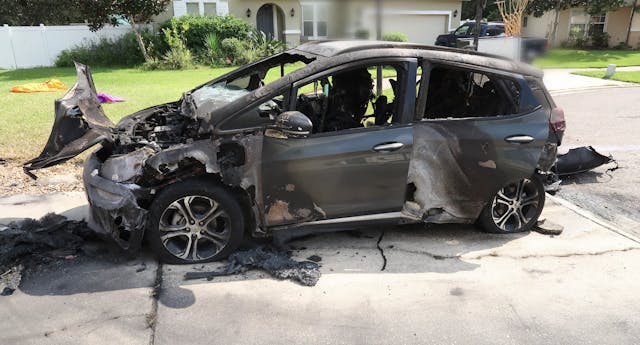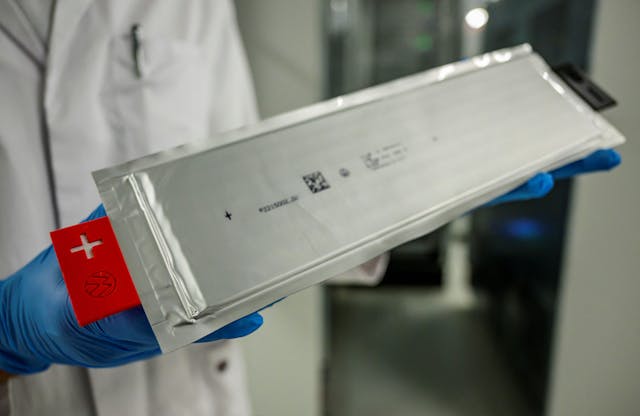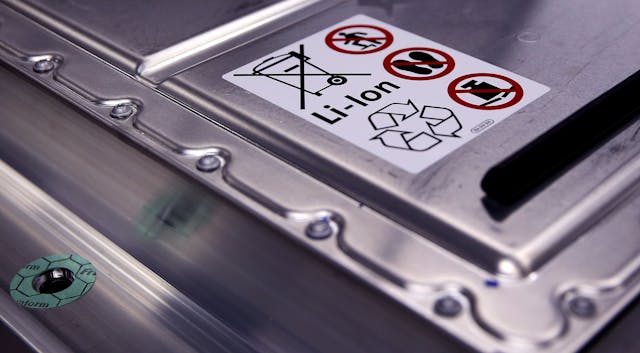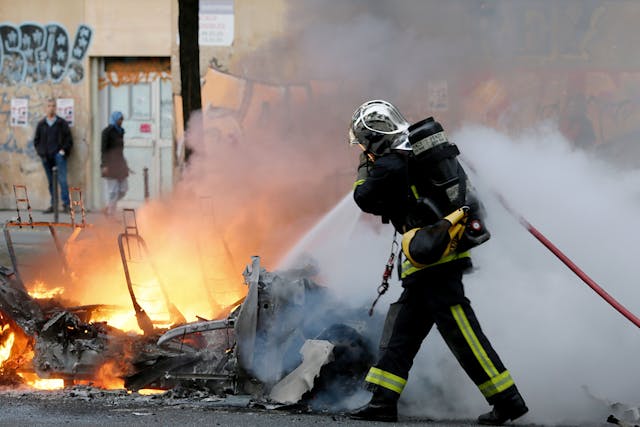Media | Articles
EV Fires: Not coming to a garage near you, statistically speaking
A foremost tenet of journalism 101’s tenet is sensationalism. To earn front-page, first-edition play, a feature story must boost the reader’s pulse. To preclude page turning, every print, digital, or podcast journalist’s goal is to set the plot hook fast and deep.
Flaming Ford Pintos were once hot news. In 1979, after three Indiana teens perished en route to soccer practice in a Pinto, the Ford Motor Company was accused of reckless homicide. Though the jury’s verdict was not guilty, Ford soon thereafter recalled Pintos to improve their rear-end crash performance and fire resistance.
The burning sensation du jour? Battery electric vehicle (BEV) fires. In 2018, British television director Michael Morris’s Tesla Model S suddenly burst into flames while stuck in Santa Monica Boulevard traffic. He expeditiously abandoned his hot seat while his wife Mary McCormack recorded the calamity on her cell phone.

Fortunately, there were no injuries. Unfortunately, Morris’s Tesla was a total loss. McCormack’s video depicting a blow torch erupting behind the left-front wheel went viral. Hollywood could not have contrived a more sensational spot of evening news.
EVs rising
At Tesla’s recent annual meeting, CEO Elon Musk forecast his company’s prospects:
Marketplace
Buy and sell classics with confidence
- The Tesla Model Y is on track to become the world’s best-selling car next year
- Tesla’s current sales rate of 1.5 million vehicles per annum should reach 2 million units globally by the end of 2022
- Constructing another dozen or so “giga” factories around the world will enable Tesla to top Toyota and VW’s combined manufacturing volume
Factor in equally ambitious plans by Ford, GM, VW and others to convert their ICE fleets to battery-electrics and you’ve got a lot more of this technology hitting roads than ever before. So how much of a potential risk do EV fires represent?
Facts, not fiction
According to the National Fire Protection Association, a gasoline-fueled car fire occurs every five minutes. From 2013 through 2017, there were 117,400 U.S. car fires per annum. Given the 261 million vehicles on the road at the time, the incident rate was 0.045 percent.

Since the Chevy Bolt was introduced in 2016, GM has sold over 140,000 of them on four continents. We bring up the Bolt because it recently underwent very public recall after several incidences of fire relating to its LG-sourced battery (costing the South Korean conglomerate $1.9 billion). Globally, there have been 16 fires caused by battery pack faults prompting a production interruption and across-the-board pack replacements. The incident rate for the Bolt is 0.0107 percent, or 1/4 of the average ICE car’s stat. Nevertheless, BEV fires have replaced gasoline fires on the evening news and across the internet.

The third-party online organization AutoInsuranceEZ recently published additional information after diving into data from the National Transportation Safety Board and government recall statistics. Hybrid vehicle fires ranked first with 3474.5 fires per 100,000 vehicle sales (16,051 fires). Next came ICE cars with 1520.9 fires per 100,000 sales (199,533 fires). BEVs were at the very bottom of this calamity heap with only 25.1 fires per 100,000 vehicle sales (52 fires).
In the 2020 recall category, nearly a million Hyundai Elantras, Kia Cadenzas, Kia Sportages, and Honda Odysseys (all ICE vehicles) were recalled due to electrical shorts. Compare that to 152,000 Hyundai Kona EVs and Chevrolet Bolts recalled in the same period over potential battery faults.
How lithium-ion works
Lithium-Ion (LI) designs replaced lead-acid and nickel-metal-hydride batteries in electric vehicle applications a decade ago, because they’re far more efficient and cost-effective. Constituent parts include a cathode serving as the current collector and positive terminal, an anode for the second current collector and negative terminal, an insulating separator between the terminals, and a liquid electrolyte containing ethylene carbonate. Other materials inside LI batteries are aluminum, cobalt, copper, graphite, iron, manganese, nickel, and phosphorus.
Lithium ions (electrically charged atoms) travel through the separator to the positive terminal producing an electric current capable of powering an electric motor. When the battery is connected to a charger, that flow is reversed—from the cathode to the anode where the lithium ions remain on standby.

Today’s LI batteries operate at up to 900 volts. A Tesla Model S, for instance, contains 7920 cylindrical cells, designed by Panasonic.
In addition to the sensational Model S meltdown mentioned above, LI batteries have failed in other applications. In two separate incidents, Boeing 787 Dreamliner auxiliary power packs fitted with such batteries caught fire, prompting temporary grounding of the entire fleet of those planes. LI fires have also occurred in cell phones, hoverboards, and e-bikes.
Boiling batteries
As EV buyers manage their range anxiety, fears of fire may loom larger. Manufacturers and safety organizations well aware of these concerns have been quietly addressing the issue for a decade or more.
Tesla, for example, investigates such incidents and includes battery failures in its warranty coverage.
There are two common paths to LI battery meltdown. The first is when the driver accidentally runs over debris in the road, resulting in a hole poked through the bottom of the battery pack. Most makers guard against such damage by protecting the pack’s vulnerable bottom surface with a quarter-inch thick metal plate.

Injection-molded composite-plastic designs that are more puncture resistant, lighter, and hopefully less expensive are under development to replace today’s battery pack housings.
The second adversity is an internal short circuit resulting from a manufacturing defect. In both this case and in the event of a puncture, the results are the same. Heat generated by the short ignites ethylene carbonate in the liquid electrolyte. Thermal runaway—when heat from one shorted cell lights a neighboring cell—ensues and fire spreads throughout the battery pack.
Packs have vents to relieve excessive pressure in a controlled manner, and cooling systems diminish the chance of overheating. But when a chain reaction occurs, the resulting heat and flame rapidly consume the entire vehicle.

Mitigating efforts to date
Like every vehicle sold in the U.S., BEVs must pass stringent National Highway Traffic Safety Administration (NHTSA) tests. This includes severe frontal barrier, rear and side impact, roll-over, and partial-front-overlap collision tests. Any short circuit within the battery pack would result in a failure to earn NHTSA’s blessing. In addition, manufacturers test to assure that no BEV subjected to flood water poses a hazard to occupants or responders.
Recently, the U.S. Department of Transportation has required every EV maker to submit specific recommendations for extinguishing fires which are summarized and forwarded to responders.
Three years ago, SAE International published a Recommended Practice document addressing EV and hybrid-vehicle chemical, electrical, and thermal hazards. This publication includes recommended procedures for emergency responders as well as those who tow and salvage such vehicles.

According to Andrew Klock, emerging technologies manager at the National Fire Protection Association (NFPA) in Quincy, Massachusetts, “Because BEV fires are significantly different from ICE car fires, firefighters need training focused specifically on this issue. We’re gearing up to provide that education.”
Founded in 1896, the non-profit NFPA offers multiple forms of responder training: in classrooms, via online webinars, and by live-virtual programs. It also has a certification process. NFPA’s expertise comes from partnerships with EV makers, the Fire Protection Research Foundation, and 15 other global organizations.
“Thus far over 300,000 first responders have been trained but another 800,000 firefighters still need our expertise,” Klock adds.
Earlier this year, GM gave the NFPA $225,000 to fund training to 12,000 volunteer and “underserved” U.S. fire departments. (Roughly two-thirds of U.S. fire departments are part-time or manned by volunteers.) GM has also initiated a first-responder training effort. Joe McLaine, a GM product safety and systems engineer, explains that “[GM] training offers unique material and hands-on experience to help responders’ awareness while safely interacting with BEVs in distress.’
In GM electric vehicles, orange-colored wiring indicates high voltage. Yellow stickers indicate where to disable the vehicle’s 12-volt circuits.
Fighting BEV fires
There are two competing fire-fighting strategies. GM’s preference, McLaine explains is to apply “large volumes of water to suppress LI fires.” NHTSA advises fire departments to simply allow lithium-ion fires to burn themselves out if there’s no immediate threat to life or nearby property. This diminishes the chance a responder will receive a high-voltage electric shock and the likelihood of re-ignition after the residue is transferred to a salvage yard. It’s all too common for BEV fires to relight several days—or weeks—after they’re extinguished.
Europe may be the global leader fighting BEV fires. A year ago, Austria-based Rosenbauer introduced an interesting Battery Extinguishing System Technology (BEST). This $30,000-$35,000 tool consists of two units—a controller and an extinguisher which is slid under the burning vehicle. Upon the operator’s command, a “stinger” rises vertically to pierce the battery pack’s bottom surface, then sprays water inside to cool the blaze. For low-slung EVs, use of the BEST device requires some lifting or tilting of the burning vehicle.
One benefit of this device is that the operator stays 25 feet from the fire; another is the 8 gallons per minute fluid flow is far less than what’s normally used. Rosenbauer claims that as little as 500 gallons can extinguish a BEV fire in less than an hour, versus the several thousand gallons and up to 24 hours normally required. Long-duration fires are a concern in part because they can result in the total depletion of a responder’s self-contained breathing apparatus.
No U.S. dealer we spoke to has delivered BEST equipment but sales are expected once departments begin budgeting for the tool in response to the rapid increase in the volume of EVs on the road.
A second procedure popular in Europe is to submerge the entire vehicle in a tank of water for 24 hours to cool residual hot spots.
According to David McInally, the chief at a Michigan township fire department near Detroit metro airport, “The use of fluids to extinguish battery fires is now in flux partly because there’s little data available thus far from car makers. Due to the vast quantities of water required, hydrant hook-ups are preferred if they’re available. Transferring the burned-out vehicle to a water-filled pit is also under consideration.
“Because there is [an EV] car maker in our township, we monitor building codes applicable to the manipulation of cells within packs and the storage of LI battery materials. We tap on-line multi-media to learn more on this subject. With more and more traveling our roads, it’s definitely a pressing issue.” Asked if he fears electric shocks traveling from a burning EV to the firefighter via the extinguishing stream, McInally rates that “a very rare possibility.”
Eliminating flammable electrolyte
In 2017, John Goodenough, who received the Nobel Prize for inventing LI batteries, published a treatise outlining a new type of battery—the solid-state design. The breakthrough here is replacing flammable liquid electrolyte with a non-combustible solid polymer, ceramic, or glass material. Other benefits include up to three times the energy density of today’s LI cells, longer life, faster charging, minimal cooling requirements, and better performance at sub-zero temperatures.
While miniature non-rechargeable solid-state batteries are already in use within human heart pacemakers, scaling them up in mass production for BEV use poses a major challenge. A joint venture between Toyota and Panasonic claims well over 1000 patents in this field and Toyota previewed autonomous people movers powered by solid-state batteries at the 2020 Tokyo Olympic games. Nissan and Mercedes-Benz are next in line. Hybrids and/or BEVs with solid-state batteries should appear relatively soon and hopes are widespread that this breakthrough will begin supplanting today’s LI batteries by the end of the decade.
An auspicious new player
While there are already a dozen major LI battery manufacturers around the globe, start-up organizations aren’t afraid to disrupt the status quo. Mujeeb Ijaz founded ONE in Novi, Michigan, two years ago, bringing ample experience to the energy storage party: sixteen years developing EVs and fuel cells at Ford, a combined nine years of effort at Apple and A123, and eighteen patents in his name.
ONE—standing, ambitiously, for Our Next Energy—currently has 153 personnel, plans to begin production by the end of 2023, and an engineering office in Fremont, California, aimed at tapping West Coast talent.

Ijaz’s intention is a reinvention of the LI battery without resorting to a solid-state design. His goals are to double vehicle range with improved energy density, eliminate any chance of meltdown, and offer a chance at a supply chain resistant to global conflicts (all materials sourced in the Western Hemisphere).
Last December, a Tesla Model S equipped with an experimental ONE dual-chemistry battery logged 752 miles over Michigan roads. The BMW iX is next in line.
“We are thrilled to be working with BMW to demonstrate our Gemini long-range technology to consumers,” Ijaz adds. “We plan to pack twice as much energy in our batteries so BEVs can handle long-distance driving during winter, climbing mountains, and while towing.”
BMW just led ONE’s $65-million funding round, suggesting that OEMs are both on the lookout for battery innovation and willing to pay up for it.
Let us return to the admittedly sensationalist question posed at the beginning of this story—is a raging BEV fire heading toward your garage? Statistically it’s very unlikely. The data is crystal clear; such incidents are far rarer than gasoline fires. If that doesn’t allay your concerns, comprehensive efforts are underway to control BEV meltdowns when they happen, and brilliant engineers are working to improve and reimagine battery technology as we know it.
Like you, as long as we can keep our beloved cars on the road we’ll refrain from cutting up our Shell credit card. But if we are going to be critical of BEVs, as we should of any new technology, let’s do it armed with the facts. Anything less is fanning the flames of misinformation.

















